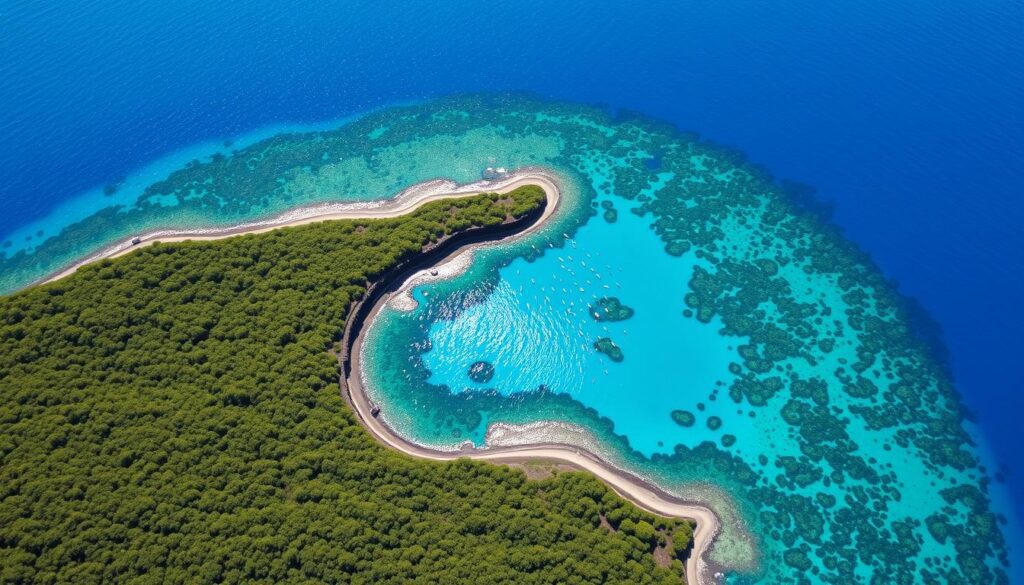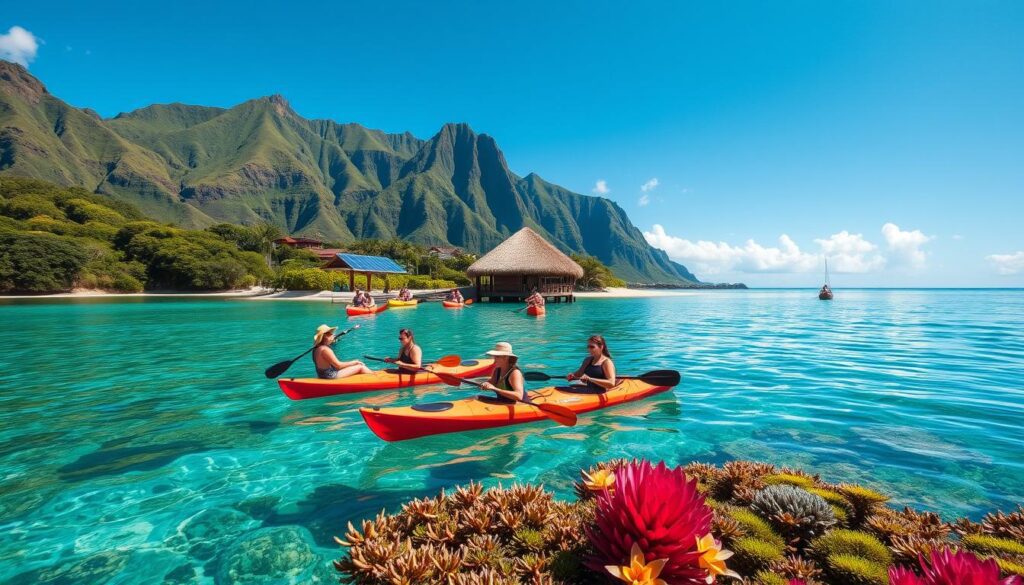Hawaii, celebrated for its breathtaking landscapes, leads the eco-tourism charge globally. The Sustainable Tourism Association of Hawaii (STAH) plays a pivotal role. As a non-profit, it champions the preservation of Hawaii’s natural splendor and cultural heritage. It does so through the promotion of eco-conscious travel and educational initiatives.
STAH’s mission is to inspire visitors to experience Hawaii with reverence for its Native Hawaiian traditions, wildlife, and environment. It also values the local community’s well-being. This approach ensures that tourism respects the land and its people.
STAH distinguishes sustainable tourism leaders through an independent verification system. It also offers the Pono Traveler program to aid certified operators in enhancing their eco-friendly practices. This dedication to eco-tourism supports Hawaii’s sustainability objectives, set for 2050. These goals aim to honor local culture, balance economic and environmental needs, and ensure future generations’ prosperity.
Key Takeaways
- Hawaii is a leader in eco-tourism, with a focus on sustainable and responsible travel experiences.
- The Sustainable Tourism Association of Hawaii (STAH) promotes the protection of Hawaii’s natural environment and host culture.
- Hawaii has set ambitious sustainability goals to be achieved by 2050, emphasizing respect for local culture and environmental preservation.
- Visitors are encouraged to engage in eco-friendly activities and respect the natural surroundings to minimize their impact.
- Hawaii’s eco-tourism initiatives include sustainable practices in the hospitality industry and support for local businesses and communities.
Introduction to Hawaii’s Eco-Tourism
Hawaii, celebrated for its breathtaking landscapes and rich cultural traditions, has adopted eco-tourism to protect its ecosystems and enhance visitor experiences. As a pioneer in sustainable travel, the islands of Hawaii provide a unique chance to delve into the essence of eco-tourism and sustainable tourism.
Definition of Eco-Tourism
Eco-tourism emphasizes reducing environmental impact, honoring local culture, and supporting conservation efforts. In Hawaii, this ethos is deeply ingrained in the values of “Malama ka’aina” (to care for the land) and “Malama ke kai” (to care for the ocean), dating back to the first settlers.
Importance of Sustainable Tourism in Hawaii
Hawaii boasts more endangered species than any other place, with over 90% of its flora and fauna unique to the islands. More than 20% of marine life in the Hawaiian archipelago is endemic. Thus, preserving these ecological wonders is paramount. Sustainable tourism is essential to protect Hawaii’s environment and cultural heritage for the future.
The significance of sustainable tourism in Hawaii is immense. With tourists outnumbering residents by about 6:1, the 8.3 million visitors in 2014 posed a significant environmental impact on Hawaii’s ecosystems and culture. By embracing eco-tourism and sustainable practices, Hawaii can maintain its status as a top destination while safeguarding its natural and cultural treasures.
Snorkeling at the Molokini Crater

The Molokini Crater, a crescent-shaped islet off Maui’s coast, is a snorkeler’s paradise. It’s known for its exceptional underwater visibility, reaching up to 150 feet on clear days. Formed by a volcanic eruption over 230,000 years ago, it now hosts a rich marine ecosystem with diverse species.
Marine Life Conservation District
The Molokini Crater is part of the Marine Life Conservation District. This protected area safeguards the coral reefs and marine biodiversity. Snorkelers can explore this underwater oasis, encountering nearly 250 fish species and 38 coral species. The crater’s crescent shape offers a sheltered environment, ensuring exceptional water clarity and a glimpse into the vibrant underwater world.
Diverse Marine Species and Coral Reefs
The Molokini Crater is a marine life haven. Snorkelers will see vibrant tropical fish, sea turtles, and sometimes reef sharks. The coral reefs lining the crater are equally captivating, showcasing a kaleidoscope of colors and supporting a thriving ecosystem.
Snorkeling at the Molokini Crater is a must for Maui visitors. With its unmatched visibility, diverse marine life, and protected status, it offers a unique and sustainable underwater experience.
Hakalau Forest Wildlife Nature Reserve
The Hakalau Forest Wildlife Nature Reserve, founded in 1985, is a haven for nature lovers and wildlife photographers. It covers 32,733 acres on Mauna Kea’s windward slopes, on Hawaii’s Big Island. This sanctuary focuses on saving endangered bird species and protecting the area’s biodiversity.
Conservation of Endangered Bird Species
The Hakalau Forest Unit is a sanctuary for 29 critically endangered bird species. The ‘Akiapōlā’au, with its unique bill, is especially vulnerable. With only about 2,000 individuals left, the reserve is home to 61% of this species.
Other endangered birds include the Hawaiian Creeper and the Hawaiian Hawk. The U.S. Fish and Wildlife Service is working to protect these species. They follow the 2021 Hakalau Forest National Wildlife Refuge Station Master Plan to guide their efforts.
The Friends of Hakalau Forest organization is crucial in managing the reserve. They plan to create two interpretive areas and support projects for greenhouses and nēnē. Their Fall 2024 Endowment Campaign aims to raise $350,000 to support the reserve’s work.
Visitors to the Hakalau Forest Wildlife Nature Reserve can explore a vibrant ecosystem. They can see the conservation efforts up close. Hiking trails in the 32,830-acre Hakalau Forest Unit and the 15,448-acre Kona Forest Unit offer great wildlife photography spots. Here, visitors can capture the beauty of endangered species and their habitats.
Hawaii Volcanoes National Park
Nestled on the Big Island of Hawaii, Hawaii Volcanoes National Park is a must-visit for nature lovers and eco-tourists. It’s a UNESCO World Heritage Site, home to two active volcanoes: Mauna Loa and Kilauea. Visitors get to see the island’s landscapes being shaped by these dynamic geological processes.
Hiking Trails and Diverse Terrains
The park offers over 150 miles of hiking trails, showcasing various terrains. From desert landscapes to lush rainforests, there’s something for everyone. Visitors can explore glowing craters, lava flows, and the Thurston Lava Tube. The scenic drives, like Chain of Craters Road, offer stunning views of the volcanic landscapes.
In 2013, the park welcomed over 1.5 million visitors, who spent $124.9 million locally. This supported 1,476 jobs, showing the park’s economic impact. Visitor numbers rose by 6.7% from the previous year, highlighting the park’s growing appeal.
The park offers educational programs like ranger talks and guided tours. These enhance the visitor experience by teaching about the island’s unique features. Accommodations like the Volcano House and camping in Volcano Village promote sustainable tourism.
Hawaii Volcanoes National Park stands out with its UNESCO World Heritage status and diverse trails. It offers a unique chance to witness the power of active volcanoes. It’s a top spot for nature preservation and eco-tourism in the Hawaiian Islands.
Hawaii Eco-Tourism

Hawaii’s eco-tourism scene offers a variety of ways to explore the islands with minimal environmental impact. In 2019, over 10 million tourists visited, outnumbering locals by about 6 to 1. This surge in visitors has made sustainable travel in Hawaii crucial.
Sustainable Travel in Hawaii
Sustainable travel in Hawaii means choosing certified tour operators and engaging in eco-friendly activities. It also involves supporting local communities and conservation efforts. Visitors can find tour companies that focus on environmental protection and responsible tourism. Activities like snorkeling, hiking, and zip lining allow guests to enjoy Hawaii’s beauty while reducing their carbon footprint.
Eco-Friendly Activities
- Snorkeling at the Molokini Crater, a Marine Life Conservation District
- Exploring the Hakalau Forest Wildlife Nature Reserve, a haven for endangered bird species
- Hiking the diverse terrains of Hawaii Volcanoes National Park, a UNESCO World Heritage Site
- Participating in coffee plantation tours to learn about the history of Hawaii’s coffee industry
- Embarking on Atlantis Submarine tours for an underwater exploration of the coral reef
- Zip lining through the island’s lush canopies with experienced guides
By participating in these eco-friendly activities, visitors help preserve Hawaii’s unique ecosystems. They also support local communities committed to sustainable tourism. Hawaiian phrases like “Malama ka’aina” and “Malama ke kai” emphasize the importance of protecting the land and sea for future generations.
To be a more eco-friendly traveler in Hawaii, visitors should use reef-safe sunscreen and clean up the beach. Supporting local businesses and eco-minded tour companies is also key. Additionally, cleaning shoes before visiting a farm is essential. Resources for ecotourism in Hawaii include the Sustainable Tourism Association of Hawaii, Hawaii Reef Ocean Coalition, and Hawaii Green Business Award Winners.
Coffee Plantation Tours
Hawaii, though not the first thought for coffee lovers, is home to renowned Kona coffee. These tours offer a deep dive into the history and growth of this prized agricultural product.
Visitors get to see the entire journey of Kona coffee beans, from growth to processing. They explore the Kona region’s stunning landscapes. This experience highlights the sustainable farming that makes Kona coffee so unique.
| Coffee Plantation | Tour Details | Highlights |
|---|---|---|
| Greenwell Farms | Daily tours from 8:30 a.m. to 4 p.m. | Educational and immersive opportunities |
| Heavenly Hawaiian | Grows, processes, and roasts three varieties of 100% Kona coffee | Award-winning, such as First Place in the Hawaii Coffee Association’s Cupping Contest |
| Kaʻu Coffee Mill | Free “Seed to Cup” farm tours daily at 10 a.m., 12 p.m., and 2 p.m., lasting approximately 30 minutes | Showcases the coffee production process from farm to cup |
| Big Island Coffee Roasters | Farm tour costs $30 for up to 6 people and $10 for each additional person | Showcases the coffee production process from farm to cup |
| UCC Hawaii Kona Coffee Estate | Estate tour hours are from 9:30-3:00, with opportunities to create a custom roast and label | Personalized coffee experience |
| Pacific Coffee Research | Offers specialty coffee classes and workshops for visitors at all levels of experience | Covers topics such as pour-over skills, coffee tasting, and home roasting basics |
These tours are perfect for all, from couples to families. Visitors love the fun, interactive learning about Kona coffee’s cultivation and processing.
These tours focus on sustainability and eco-tourism. They offer a chance to dive into Hawaii’s agricultural heritage and support local businesses. Guests can enjoy the scenic views, see the coffee’s meticulous growth, and taste the unique flavors of Kona coffee.
Atlantis Submarines
Atlantis Submarines offers a unique and sustainable way for visitors to explore Hawaii’s marine ecosystems. These battery-powered submarines provide an up-close encounter with the diverse coral reefs and abundant marine life. All this is done while minimizing environmental impact.
Launched in 1988 in the Waikiki, Lahaina, and Kona regions, Atlantis Submarines has welcomed millions of guests. In 2005, the company sank the 97-foot Carthaginian ship to create an artificial reef. This reef has since become a thriving habitat for various fish and marine creatures.
Sustainable Underwater Exploration
Atlantis Submarines operates using the world’s most technologically advanced passenger submarines. These can reach depths of over 100 feet without emitting any pollutants or noise. This commitment to eco-friendly practices is at the core of the company’s philosophy.
The Atlantis XIV submarine, based in Hawaii, can accommodate up to 64 passengers. It is the world’s largest passenger submarine. Since its inception in 1988, Atlantis Submarines Hawaii has served over 9.9 million passengers. The company has completed over 500,000 submarine dives worldwide.
Atlantis Submarines’ dedication to sustainable tourism has not gone unnoticed. In 2024, the company was ranked #2 in the USA TODAY 10Best’s Readers’ Choice Award for Best Tour Company in Hawaii. This further solidifies its position as a leader in eco-friendly exploration of the underwater realm.
Zip Lining Adventures
Zip lining has emerged as a favorite eco-tourism activity in Hawaii. It allows visitors to see the islands’ stunning scenery from above. With the help of skilled guides and secure safety harnesses, this activity offers a thrilling way to see Hawaii’s landscapes. It does so while keeping the environment intact. These tours are a fun, eco-friendly way to dive into the island’s splendor.
Canopy Exploration
Hawaii Zipline Tours boasts seven incredible zip lines, each promising an unforgettable ride. The last zip line crosses over a 250-foot waterfall, 400 feet above a breathtaking valley. With over 1,200 five-star reviews on Tripadvisor, they’ve been named the #1 zip line tour in Hawaii by Hawaii Magazine’s Best of the Best Awards. This recognition underscores their commitment to quality and guest satisfaction.
Experienced Guides
The tours are tailored for all comfort levels, starting with gentle lines and moving to more daring ones. Guides like Kim, Oliver, Ryan, Mark, Savannah, John, and Zach ensure a safe and enjoyable journey for everyone. With a spotless safety record, Hawaii Zipline Tours stands as the premier outdoor activity in Haiku, Maui.
| Zip Lining Package | Price |
|---|---|
| 8-Zipline Course | $148 |
| 5 Ziplines and a Suspension Bridge | $128 |
Visitors are encouraged to donate to support those affected by Maui wildfires. Using hashtags like #MauiStrong is a way to show support for local businesses and the community.
Responsible Tourism Practices
At the heart of Hawaii’s eco-tourism efforts are responsible tourism practices. These include reducing environmental impact, honoring local culture, and supporting conservation and sustainability. Visitors are urged to adopt the principles of “Malama ka’aina” (to care for the land) and “Malama ke kai” (to care for the ocean). This means engaging in eco-friendly activities, backing local communities, and celebrating native cultural heritage.
Adopting these practices helps travelers preserve Hawaii’s natural beauty and cultural traditions for the future. For example, Hawaii’s ban on coral-harming sunscreen sales in 2021 shows its dedication to environmental care. The Sustainable Tourism Association of Hawaii also certifies tour operators. This ensures they reduce their footprint and support local communities.
Choosing locally owned places to stay, eat, and shop benefits Hawaiian communities directly. Reducing single-use plastics and joining beach cleanups can significantly cut down waste. Following the “Leave No Trace” principles in nature parks and supporting local markets and events boosts sustainability and cultural richness.

Scott Sweeney is the creator of Virtual Hawaii 360. Scott is a professional marketer and a lifelong Hawaii enthusiast. Scott splits time between Oahu and Dayton, Ohio. In addition to his marketing endevours, he is also a published Ukulele musician.
